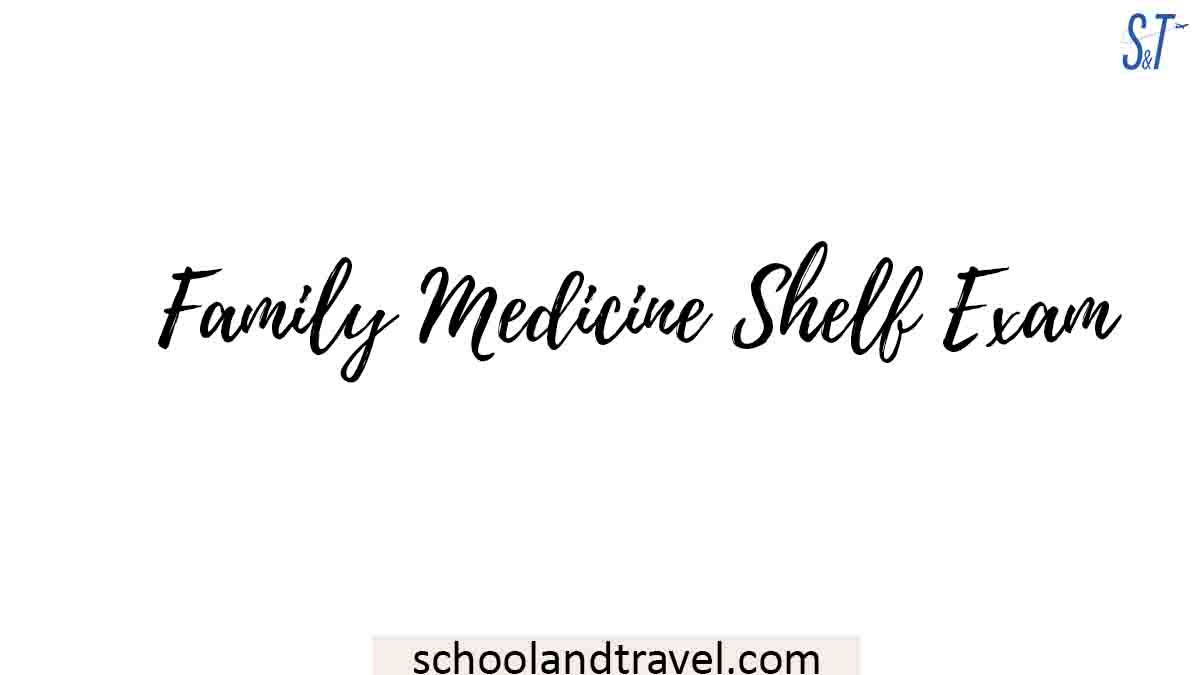Most students take the family medicine shelf exam in order to enter the family medicine rotation in the hopes of getting a break from the rigors of surgical operations and internal medicine rotations.
It’s genuine that this rotation is typically clinic-heavy, with little to no inpatient care or call.
Likewise, it’s critical not to become complacent with this rotation. A busy hospital day can be stressful, and the variety of medical issues that you may see in family medicine is vast.
What is the Family Medicine Shelf?
The family medication shelf is a synthesis of outpatient medicine from multiple specialities, including pediatrics, OB/GYN, and internal medicine.
As a result, you may want to coordinate your preparation for this clerkship and the shelf with your preparation for Step 2 CK.
Furthermore, because this rotation typically allows you to study throughout the evenings and weekends, you’ll have plenty of time to excel on the clerkship while also acing the shelf examination and, in the end, your Step 2 CK.
What is the Family Medicine Shelf Exam?
The family medicine shelf exam provides a unique challenge.
The study material that should be used to prepare for the family medicine shelf exam is quite broad, and students barely cover the entire study pack.
Thus, you may have questions about the vaccination strategy for infants, then want to know about a depressed pregnant woman, followed by wanting to know about an older adult with dementia.
Covering such subject matters and other wide range of diverse topics, and studying for the exam can be quite challenging as the exam itself.
While studying and taking the family medicine shelf exam can be challenging, the wide range of subjects in this examination can also be an extremely good opportunity.
Studying to take the exam may be very beneficial on Step 2 CK, as you’ll be revising and going through study materials that you’ve learnt in diverse fields.
Whether you need to honor your family medicine rotation or sincerely make sure that you’re ready for Step 2 CK, the proper study plan will assist you to do well.
Read this: How to study for NAPLEX (Meaning, Duration, Pattern, Application)
What Subjects are Covered for the Family Medicine Shelf Exam Board Review
- Ambulatory Medicine
- Population-Based Care
- Neurology
- Allergy and Immunology
- Psychiatry
- Nephrology
- Statistics / Study Design
- Dermatology
- Pulmonary / Critical Care
- Endocrinology / Metabolism
- Ear, Nose, Throat
- Rheumatology / Orthopedics
- Musculoskeletal and Sports Medicine
- Ethics
- Eye
- OB/GYN
- Pediatrics
- Oncology
- Hematology
- Infectious Disease
- Gastroenterology
- Geriatrics and Palliative
- Cardiovascular Disease
- Nutrition
What topics are included in the Family Medicine Shelf Exam?
According to the NBME Clinical Science family medicine Modular scheme of work, the subsequent subjects are included at the vital part of the family medicine shelf exam:
- Female Reproductive System & Breast 1% – 5%
- Blood & Lymphoreticular System 1% – 5%
- Male Reproductive System 1% – 5%
- Renal & Urinary System 1% – 5%
- Immune System 1% – 5%
- Pregnancy, Childbirth, & the Puerperium 1% – 5%
- Multisystem Processes & Disorders 1%–5%
- Nervous System & Special Senses 1% – 5%
- Biostatistics, Epidemiology/Population Health, & Interpretation of the Medical Lit. 1% – 5%
- Skin & Subcutaneous Tissue 3% – 7%
- General Principles, Including Normal Age-Related Findings and Care of the Well Patient 5% – 10%
- Behavioural Health 5% – 10%
- Social Sciences 5% – 10%
- Cardiovascular System 5% – 10%
- Gastrointestinal System 5% – 10%
- Musculoskeletal System (percentage increases with the addition of the Musculoskeletal module) 5% – 10%
- Respiratory System 5% – 10%
- Endocrine System 5% – 10%
- Systems-based practice and patient safety
- Medical ethics and jurisprudence
- Communication and interpersonal skills
In addition to the vital part of the family medicine shelf exam as listed above, elective modules in Musculoskeletal/Sports-related injury and Chronic Care are to be had as a supplement.
How to Prepare for the Family Medicine Shelf Exam:
- Attempt to fix your Medicine and Surgery examinations to come one after the other, if possible, as there tends to be a few overlaps in the subjects covered. Students who take Medicine-first do tend to have higher preparation for Surgery.
- Finish up as many practice questions and different instances as possible because the Medicine Shelf is very broad.
- Focus on topics such as endocrine disorder, respiratory, digestive and cardiovascular, as these topics make up nearly 50% of all topics in the family medicine shelf exam.
- Study all through the duration of your whole Medicine rotation and make certain to pay close attention to the wards. Knowing how to properly work up and control your patients might be useful for when you eventually sit for the family medicine shelf exam.
- Attempt each question as real diagnostic situations and practice being distinctive.
- Complete the whole internal spectrum of medicine as you prepare: take note of common situations during your clerkship and use your downtime to pay attention to the more mysterious illnesses you don’t see at the wards.
Read this: How Hard is the PCAT? (Meaning, Difficulty, How to study, Exam tips)
Sitting for the Family Medicine Shelf Exam
Not every medical student is required to sit for the family medicine shelf exam, and it’s not a compulsory examination for acquiring a US doctor’s license.
However, most medical colleges have a required medicine clerkship, and the most common manner to test students in this precise rotation is by the family medicine shelf exam.
The examination may be taken on campus at specific medical colleges or accredited exam locations.
On the other hand, the family medicine shelf exam is an online exam that consists of 110 questions that have to be answered in 165 minutes.
The exam presents its questions in the form of hypothetical clinical situations.
Moreover, the family medicine shelf exam is graded on a nationwide average, though whether or not you pass your exam solely depends on your medical school’s requirements.
Conclusion
That’s all! Good luck to every student studying to take the family medicine shelf exam.
One vital piece of information every student should note is that even as much as the family medicine shelf exam presents itself as difficult to pass, students preparing to take the exam should not allow such a myth to affect their preparation.
Awesome one; I hope this article answered your question.
Share this Information.
Editor’s Recommendations:
- How to Create a Balanced Plate: The Key to Healthy Eating
- How to Start a Virtual Book Club with Friends
- The Top Credit Score Hacks Every Young Adult Should Know
- The Pros and Cons of Rental Property as a Passive Income Stream
- Enhancing Your Clinical Psychologist Job Prospects with Professional Help
- The Impact of Graphic Design School on Your Future Earnings Potential
- 7+ College Scholarships for Muslim Students (FAQs)
- Flavor of the Month Scholarship 2024 (Requirements, FAQs)
- Vegetarian Scholarship (Requirement, Deadline, FAQs) | 2025
- John and Abigail Adams Scholarship 2022-2024 (Eligibility, Deadline)






